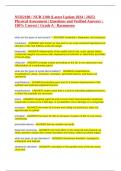NUR2180 / NUR 2180 (Latest Update )
Physical Assessment | Questions and Verified Answers |
100% Correct | Grade A - Rasmussen
what are the types of eye lesions? - ANSWER hordeolum, blepharitis, and chalazion
hordeolum - ANSWER also known as stye and it's an acute localized staphylococcal
infection of the hair follicles at the lid margin.
blepharitis - ANSWER inflammation of the eyelid and its red, scaly, greasy flakes,
crusted lid margins occurrence with staphylococcal infection or seborrheic dermatitis
of the lid edge.
chalazion - ANSWER a beady nodule protruding on the lid, it's an obstruction and
inflammation of a meibomian gland.
what are the types of eyelid abnormalities? - ANSWER exophthalmos,
enophthalmos, ptosis, ectropion, entropion, periorbital edema, and basal cell
carcinoma
exophthalmos - ANSWER protruding eyes and its a forward displacement of the
eyeballs and widened palpebral fissures.
enophthalmos - ANSWER sunken eyes that is a look of narrowed palpebral fissures,
in which the eyeballs are recessed.
ptosis - ANSWER drooping upper lid and it occurs from neuromuscular weakness,
oculomotor cranial nerve 3 damage, or sympathetic nerve damage or is congenital.
ectropion - ANSWER the lower lid is loose and rolling out (eversion), does not
approximate to eyeball.
entropion - ANSWER the lower lid rolls in because of spasm of lids or scar tissue
contracting.
periorbital edema - ANSWER lids are swollen and puffy
basal cell carcinoma - ANSWER it is most often on the lower lid and presents as
small, painless nodule with central ulceration and sharp, rolled-out pearly edges.
what are types of eye disorders? - ANSWER strasismus deviation, nystagmus,
ambylopia, and diplopia
strabismus deviation - ANSWER a deviation in the parallel axes of the two eyes,
cross-eye




